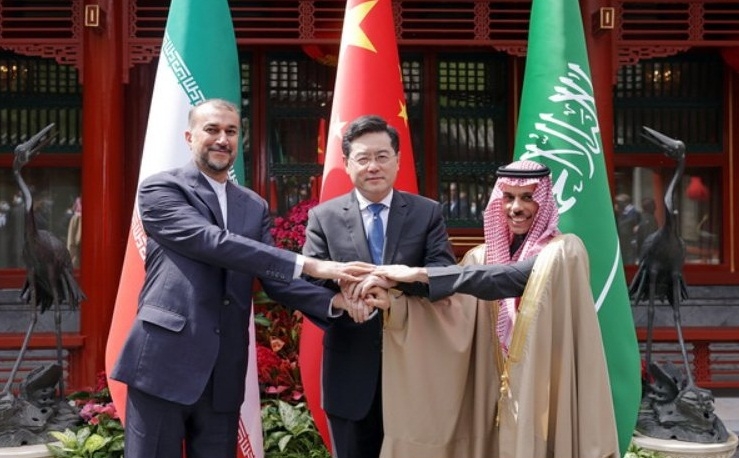New Delhi, April 17 (IANS) The images of Saudi Foreign Minister Prince Faisal bin Farhan and his Iranian counterpart Hossein Amir-Abdollahian flanking Chinas Foreign Minister Qin Gang - all three smiling and clasping hands - are an indication of the easing of tensions between the two bitter Gulf rivals as well as of Beijings growing influence and ambitions in the Middle East and on the global stage, John Calabrese wrote in an article for the think-tank Middle East Institute. Beijing's diplomatic initiative signifies a willingness to assume a degree of responsibility for stability in the region and the risks associated with it that China had previously seemed strongly inclined to avoid. China's diplomatic foray into the region should also be viewed against the backdrop of its foreign policy reset and its push to build a post-American international security architecture, the article said. For more than seven years, diplomatic and military hostility between Riyadh and Tehran has fuelled instability and conflict across the region. However, at a meeting on April 6 in Beijing, Saudi Arabia and Iran's top diplomats confirmed the reopening of their embassies and consulates, as well as the resumption of direct flights and facilitation of visas for the citizens. The meeting followed the agreement signed by the two sides on March 10, also in Beijing, to resume diplomatic relations - a deal brokered by China that built upon more than two years of exploratory talks by Iraq and Oman. There can be little doubt that the opportunity to help reduce tension in a region from which China sources nearly half its oil imports was compelling, especially with energy security having risen to the top of Beijing's policy agenda in the context of global market turmoil. But Beijing's diplomatic foray into the region should also be viewed against the backdrop of China's foreign policy reset, Calabrese said. Since Chinese leader Xi Jinping unveiled his Global Security Initiative (GSI) at the Boao Forum in April 2022, and especially in light of a consolidation of power that has made Xi China's most dominant leader since Mao Zedong, Beijing has been waging a diplomatic offensive. While striking a more combative tone towards the United States, Chinese officials have been keen to repair and reinvigorate relations with Europe. But it is the Global South that the Chinese leadership appears to regard as central to its aim of pushing back against US and Western hegemony through establishing an alternative multilateral order and positioning itself as a peaceful global security provider, Calabrese said. China's GSI concept paper, issued in February, provides a broad outline for how China envisions a post-American international security architecture, and details how Beijing would help achieve stability, including in areas where geopolitical tension and conflict is endemic. There are those who will regard Beijing's flurry of diplomatic activity as merely performative - heavy on core concepts and principles but light on actionable plans. Similarly, in the case at hand, some will be tempted to view Beijing as simply having officiated at a ceremony where two willing parties enlisted its good offices to carry them across the finish line, the article said. The months ahead will provide opportunities to test the proposition that China is both willing and able to use its leverage to help ensure the parties follow through on their commitments. Yet one thing is clear: Not only has China established itself as the Middle East's leading foreign economic partner, but it has also emerged as a major strategic player at the centre of the region's geopolitics. CIA Director Bill Burns told Saudi Arabia's Crown Prince Mohammed Bin Salman that the US feels "blindsided" by Riyadh's moves to restore ties with Iran and Syria as part of the kingdom's increasingly independent foreign policy streak, Middle East Eye reported. Burns travelled to Saudi Arabia at an undisclosed time this week to discuss intelligence cooperation with the Saudi Arabians. During the meeting, he expressed Washington's frustration at being left out of regional developments, according to the Wall Street Journal. The visit, first reported by the Washington Post, followed a series of surprise diplomatic breakthroughs by Riyadh that has left the US on the sidelines, fanning talk of the US' waning influence in the region. Last month, Saudi Arabia had agreed to re-establish ties with Iran, in a deal brokered by Washington's arch-rival China, Middle East Eye reported.
Beijing flaunts its growing influence and ambitions in the Middle East
- by Rinku
- April 17, 2023 2 minutes

Beijing flaunts its growing influence and ambitions in the Middle East.(photo:Twitter)











